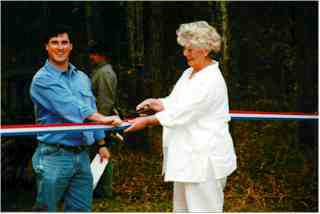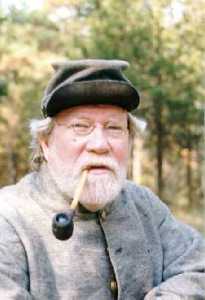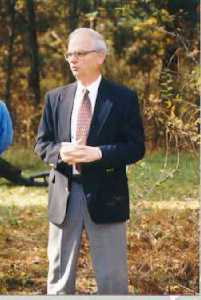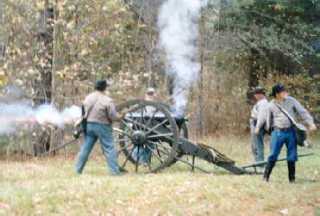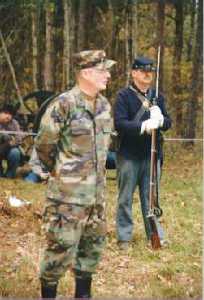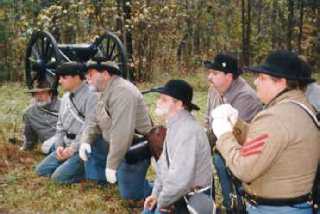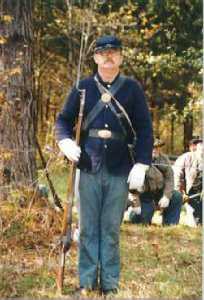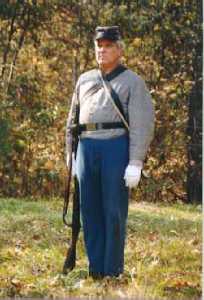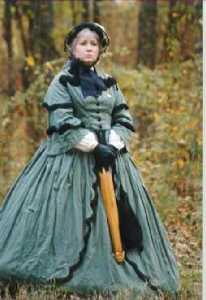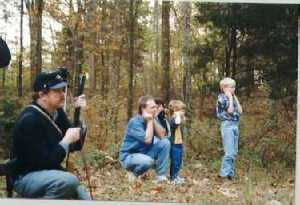|
Ribbon Cutting for Endangered Battlefield by Rebecca Blackwell Drake Saturday, November 28th, at 1:00 p.m. was a proud day for the City of Raymond and for all interested in the preservation of its historic sites. David McCain, President of the Friends of Raymond, and Isla Tullos, Mayor of Raymond, delighted the crowd by cutting the ribbon to the newly purchased core portion of the battlefield. Local television stations were present to capture the historic event as it unfolded.
Prior to the ribbon cutting, David McCain addressed the audience and discussed the reasons for the purchase of the battlefield. "The first reason for sealing the purchase of the battlefield," stated McCain, "was for historic preservation. It was on this site that one of the most important battles of the Vicksburg Campaign was fought. The battlefield in Raymond, as well as other historic properties in town, witnessed defining acts of our nation's history. The Civil War was a time when people of all descriptions and origins rebuilt their world in a completely new and better pattern.
"The second reason for the purchase of the battlefield was for educational purposes. Roles of every component of society were important from the farmers and planter's wives to slaves, bankers and generals. There are many stories left untold that need to be told. A visitor's center on the Battlefield could help educate the youth of our town as well as the tourists who will visit in the years to come. "Economic development would be the final reason for preservation. Heritage tourism is one of the nation's fastest growing industries. Over one million visitors come to the Vicksburg Military Park a year. Development of a major Civil War site in Raymond, including walking trails, campgrounds and perhaps an interpretative center, could mean economic dollars to Raymond. The battlefield as a tourist attraction would help support general businesses. It would also attract new businesses such as restaurants, bookstores and antique stores. This type of economic growth would be good for Raymond.
"Raymond is a part of a wider vision as a part of the Friends of Vicksburg Campaign and Historic Trail. These organizations, in Vicksburg as well as in Raymond, are working to preserve, interpret, manage and promote a 200 mile long trail through three parishes in Louisiana (East Carroll, Madison and Tensas) and three counties in Mississippi (Claiborne, Hinds and Warren.) "The objective will be to present the entire Vicksburg Campaign in such a way that an interested scholar or tourist will be able to follow the Campaign Trail from its inception at Young's Point in Louisiana to its conclusion at Vicksburg." Also introduced and invited to address the audience was Elbert Hilliard, Director of the Mississippi Department of Archives and History. "Across the country there is a great deal of activity and interest going on in making sure that the significant battlefields are preserved," stated Hilliard. If this is to be done it will certainly necessitate the cooperation of citizens on the local level. We need to make a push during this session of the Legislature and try and get funding and support for an overall preservation effort for the sites associated with the Vicksburg Campaign."
Adding to the excitement of the day was the presence of Stanford's Battery who fired a Civil War cannon in tribute. Dick Kilby, board member of the Friends of Raymond, displayed items of interest recently excavated by Gordon Skelton from the battlefield. Among these items were mini-bullets and a metal plate once worn by a Union soldier. The Friends of Raymond will continue to work toward the preservation and development of the battlefield. The organization encourages you to join and contribute toward preserving one of our most important historical sites. Unlike the Battle of Raymond, which took place on a hot and dusty day during the spring of 1863, the battlefield ribbon cutting was held on a picture-perfect November day. Civil War historians, as well as citizens of Raymond, gathered on the historic battlefield to celebrate the purchase of the battlefield property.
"If you picture yourself back in May of 1863," Hill began, " it was a very hot and dusty summer day. The Union corps of James McPhearson had been moving up from Utica. The problems of dust were so intense the soldiers had wrapped bandanas around their noses to try and stop from sucking in the dust from the brigades in front of them. Because of that, the corps had spread itself over several miles up and down the road now known as Highway 18. "General John Gregg, a very aggressive man on the Confederate side had been sent down to Raymond with the instructions of hitting the right flank of the Union Army. When he got here, he presumed that he was facing a brigade of roughly 2,500 soldiers on the Union side. Since General Gregg had 3,000 men, attack seemed to be the thing to do. Unfortunately, for the Confederates, there were roughly 10,000 Union soldiers instead of 2,500. General Gregg never stood a chance with his attack. Still, he placed two good regiments along the side of the road. These units were comprised of the two main units who fought here, Tennessee and Texas.
"Most of these troops had been captured at Fort Donaldson and spent some time as prisoners of war. They had also spent a lot of time as veterans in combat. They were not at all anxious to be taken prisoner again so they were ready for a good fight. "The battle opened up at 10:00 a.m. on May 12, 1863, out on the Highway 18 area. It slowly spread to the ground where we are standing today. As the Union troops were attacking from as far away as 14-Mile Creek, the Confederates could tell that they were in dire straight because of their inferior number. With 3,000 mean facing 10,000 Union soldiers, the fate of the Confederate Army was pre-determined. "Still, the fighting progressed almost
all day long and didn't end until about 4:00 in the afternoon. This
particular part of the battlefield where we are standing was occupied by
the 10th & 30th Consolidated Tennessee regiment.
"As Colonel McGavock's men prepared to charge, he looked off to his right and saw the 41st Tennessee pulling back. He knew if he pulled back, this entire force of the Confederate line would fold. He could not retreat so he prepared to charge. As he looked off toward the front, a slight breeze came up and blew some of the dust and smoke of battle away. It was then that the Union army, some 700 yards away, was able to see McGavock and his men. They turned their artillery guns and fired. Even though he was dramatically outnumbered, Colonel McGavock ordered his men to charge.
"McGavock always wore a long cape with a bright red silk lining. He would flip this cape back so the men could see the bright red silk lining and know this was a symbol to follow. When he flipped back this cloak, he made himself a perfect target on the battlefield. The soldiers of the 7th Missouri on the Union side, an Irish regiment who spoke mostly Gaelic, opened fire and McGavock was shot dead almost immediately. Still, his men continued down the ridgeline into the 14 Mile Creek bottom and drove back the 7th Missouri. As they continued to fight, they observed that the other brigades had begun to pull back. Only then did the 10th-30th Tennessee move back. "Colonel McGavock was buried on the battlefield where he fell in an unknown place somewhere near where we are standing today. A young orderly, Griffin, who was with him during battle, was taken prisoner of war but remembered where his commander had been buried on the battlefield. He came back to McGavock's grave and helped to move the body to the Raymond Cemetery. His family later came down from Tennesse and took his body back to the family's ancestral home near Nashville and buried him there.
As a soldier reminiscing the Battle of Raymond, Colonel Hills stated that two elements were a key element to the battle: surprise and flexibility. General John Gregg surprised General McPhearson and put up an all day fight. General U.S. Grant used the element of flexibility by changing the movement of his army from Edwards to Jackson. The burning of the City of Jackson and the march back to Vicksburg ultimately sealed the victory for the Union forces. "The Battle of Raymond was a very important part of the Vicksburg Campaign," stated Hill. "This piece of ground where we are standing today, is a very important part of the Battle of Raymond. Hopefully, this will be just the first of many stepping stones to preserve Raymondís entire battlefield." Photographs by James and Rebecca Drake
| Home | Grant's March | Gregg's March | Battle of Raymond | Order of Battle | Commanders | Soldiers Who Fought | Diaries & Accounts | Copyright (c) James and Rebecca Drake, 1998 - 2002. All Rights Reserved. |
